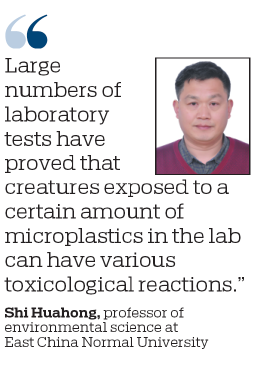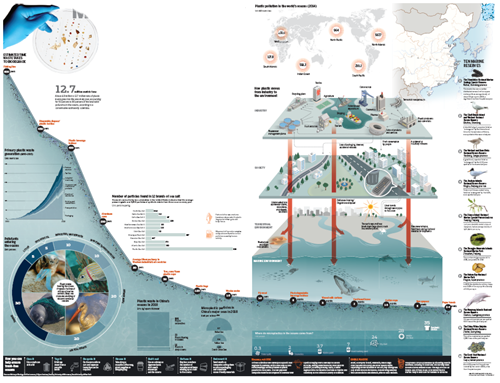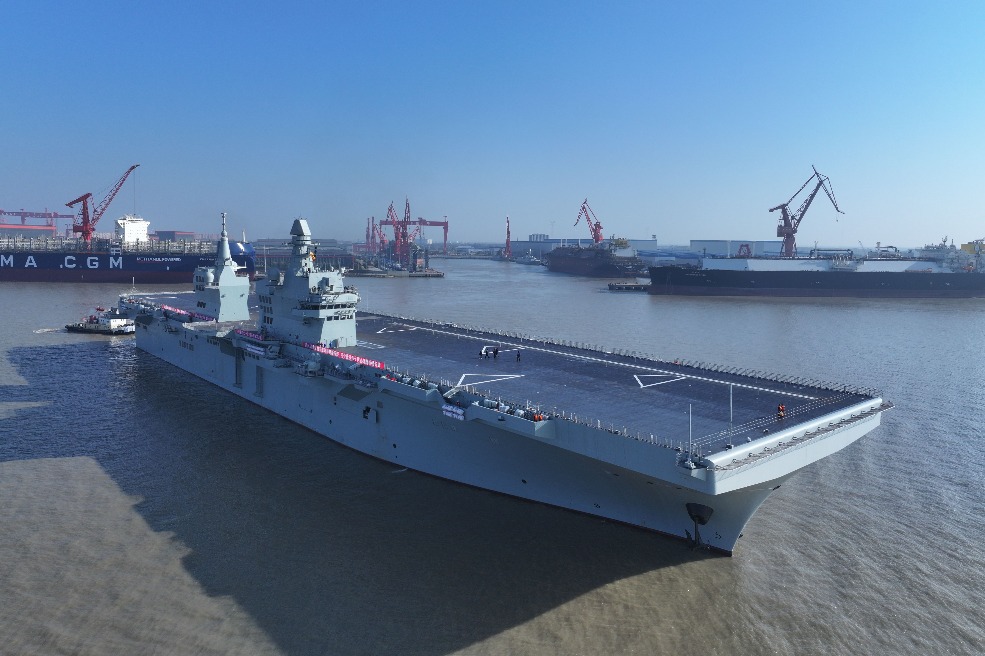MICROPLASTICS: A HIDDEN DANGER

Plastic pollution poses a major threat to the world's oceans. When the material breaks down to become microplastics, it can be more easily ingested by fish, and enters the human body via the food chain.
The 2018 China Marine Ecology and Environment Bulletin, published in May by the Ministry of Ecology and Environment, indicated that plastics account for about 80 percent of the waste in China's oceans. Microplastics were found in the Yellow and the South China seas.
The report-the result of ministry research in 57 marine areas-also said plastic waste, such as bottles and bags, accumulates at tourist sites, fishing areas and harbors.
It added that an average of 47,000 pieces of plastic were found in each square kilometer of beach, while the number was about 910 per sq km in the deep sea.
However, Huo Chuanlin, deputy director of the ministry's Department of Marine Ecology and Environment, said China should not be the most-blamed country for plastic pollution.
"China is the largest producer and exporter of plastics, but it doesn't mean it is the largest polluting country. Lots of studies prove that," Huo said in a media release on Oct 29.
In 2018, Li Daoji, a professor of oceanography at East China Normal University in Shanghai, released the results of his team's research at the Eco Forum Global Annual Conference in Guiyang, Guizhou province. The research showed that the density of microplastics in China's oceans was at a medium level, compared with other countries.
"Sometimes, research groups from different countries adopt different methods to take samples, which may cause differences in the results. A unified standard of monitoring and calculation should be promoted across the world," he was quoted as saying by China Profiles magazine.
Regardless of the pollution ranking, the amount of microplastics in the world's oceans is rising and a global war on ocean pollution is urgently needed.
According to the UN, there will be more plastic than fish in the world's oceans by 2050. Research conducted in 2014 by the 5 Gyres Institute, a nonprofit dedicated to the elimination of plastic waste, said that from 2007 to 2013, some 5.25 trillion plastic particles were floating in the oceans, weighing about 269,000 metric tons.
A 2016 report by the UN showed that about 800 marine and coastal species were found to have been affected by plastic garbage entanglement or inhalation, and microplastics have been detected in about 40 percent of cetaceans and 44 percent of seabird species.
The garbage could find its way onto our dinner tables through the food chain or sea salt, the UN said.
According to the UN Food and Agriculture Organization in 2017, humans are likely to consume 7 micrograms of microplastics with every 225 grams of shellfish.
Sea salt in the United Kingdom, France and Spain, China and the United States has also been found to contain microplastics, according to The Guardian in 2017.
Shi Huahong, professor of environmental science at East China Normal University, said that to date, there is still no strong evidence to show that microplastics can cause obvious damage to the ecosystem.
"The natural environment is complex and full of various kinds of pollutants and other environmental impact factors, so it is difficult to relate negative effects on creatures to specific pollution factors," he said.
"However, large numbers of laboratory tests have proved that creatures exposed to a certain amount of microplastics in the lab can have various toxicological reactions."
China has introduced a national campaign aimed at curbing microplastics pollution in the oceans.
In 2016, the density of marine microplastics was introduced as a routine monitoring item for the marine environment, and results are regularly posted on the official website of the Ministry of Ecology and Environment.
Also, by November, 237 cities at prefectural level or above had adopted waste-sorting programs after a nationwide campaign started in June.
"This will help to recycle plastic and prevent waste from flowing into the oceans," Huo said.


Today's Top News
- China's Shenzhou XX crew en route back to Earth
- China's economy remains generally stable in Oct
- Xi calls for advancing community with shared future when meeting Thailand's king
- Xi holds welcome ceremony for visiting Thailand's king
- China's retail sales up 2.9% in Oct
- Shenzhou XX crew set to return after space debris delay






























